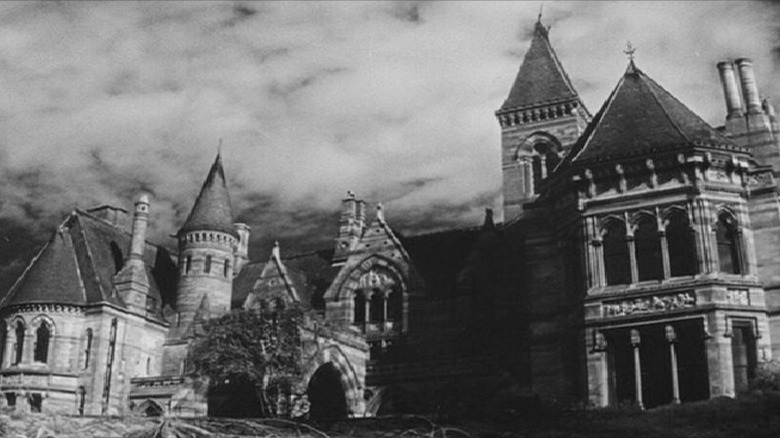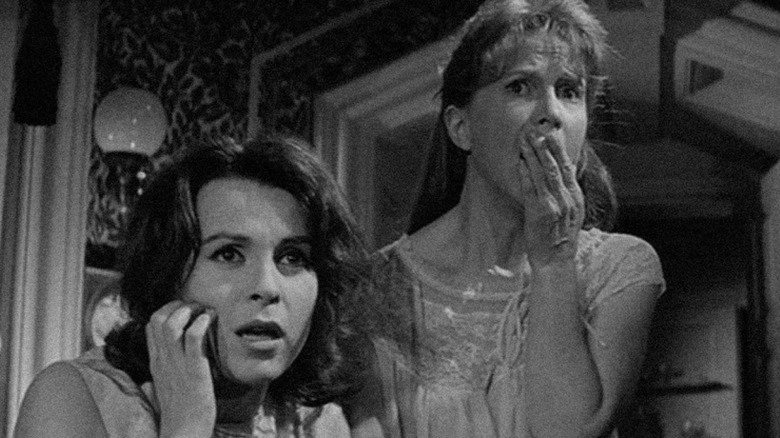The Spooky Truth About The Haunting's Ettington Park Hotel
"The Haunting" is the first adaptation of Shirley Jackson's 1959 gothic horror novel "The Haunting of Hill House." The name might ring a bell — it's one of the greatest American ghost stories of all time, and the novel was the foundation for Mike Flanagan's hugely popular Netflix horror series of the same name.
The 1963 film depicted the experiences of a paranormal investigator and a group of people he invites to investigate a haunted house. The house in question is the 90-year-old Hill House, built between many unspecified hills, designed as a series of maze-like circles that make it impossible to navigate. In the novel and the film, Hill House isn't just the story's setting. It is a living, breathing entity that harbors secrets of its own. It nurtures its residents but also turns sinister in the dark, where screams and unsetting laughter can be heard by its residents, and the presence of unknown intruders can be felt. "The Haunting" delivered the terror factor in spades when it built its setting as a massive house that could be seen as both welcoming and claustrophobic — depending on the time of the day.
While the set was designed by three-time Oscar nominee Elliot Scott, Ettington Park (now the Ettington Park Hotel) in Warwickshire was used to photograph the exterior shots of Hill House. Ettington Park was the perfect eerie setting for Hill House — but not because of its sprawling grounds and neo-gothic architecture. In its 2,000 year history, Ettington Park has been home to people, nurses, prisoners of war, and many ghost stories.
It Looks Spooky Because It Is
Today, the Ettington Park Hotel is a luxurious four-star hotel with 46 well-appointed rooms, a restaurant and a cafeteria, and pool facilities. But it wasn't always a great property. There's archaeological evidence that humans have lived in the area surrounding the hotel for over 2,000 years, and the mansion-turned-hotel used to be a Roman villa before going through multiple alterations and extensions over time. The property was owned by the Shirley family, whose lineage can be traced back to a thousand years.
It also has a reputation for being one of the most haunted hotels in the UK. Guests and members of the staff have often reported seeing various specters and hearing disembodied voices at the hotel. The ghosts of Ettington Park (there are some more familiar than others) have been spotted for decades — but they're not all dangerous. For instance, there's the ghost of a man and his dog wandering in the library and vanishing quickly. There's an older woman dressed in Victorian-era clothing seen and heard walking along the entrance to the conservatory.
Christmas Eve is festive here in a rather unconventional way — the staff has reported seeing a candle lift off its mantlepiece and floating by itself. No one would complain if that were Hogwarts, but a hotel with a history of being haunted? That's no fun.
Among Ettington Park's many spirits is its resident ghost, the Lady Emma, who notoriously disappears into walls to frighten guests and the hotel staff. They have reason to believe that she is a former governess and is always wearing a white gown, gliding along the corridors at night. There have also been sightings of the grey lady who is usually seen in the same spot she died in years ago. People have spotted a monk inside and outside the hotel, an army officer (fitting since the hotel was home to prisoners of war during World War II), and visions of two young Shirley boys who drowned in the 1800s in the Stour River.
It wasn't until 1983 that the abandoned property was leased to the Isis Hotel Company. They put in a program to restore Ettington Park and bring back its old glory. The mansion came back, all right, but its spirits seem to have returned too (or did they never leave?). The former owners — the Shirley family, reportedly still visit their old home and continue to maintain ownership of land in the areas surrounding the property. For anyone in the UK in need of a good scare — here's a hotel with attractions that run far deeper than its stone arches and towering architecture.

